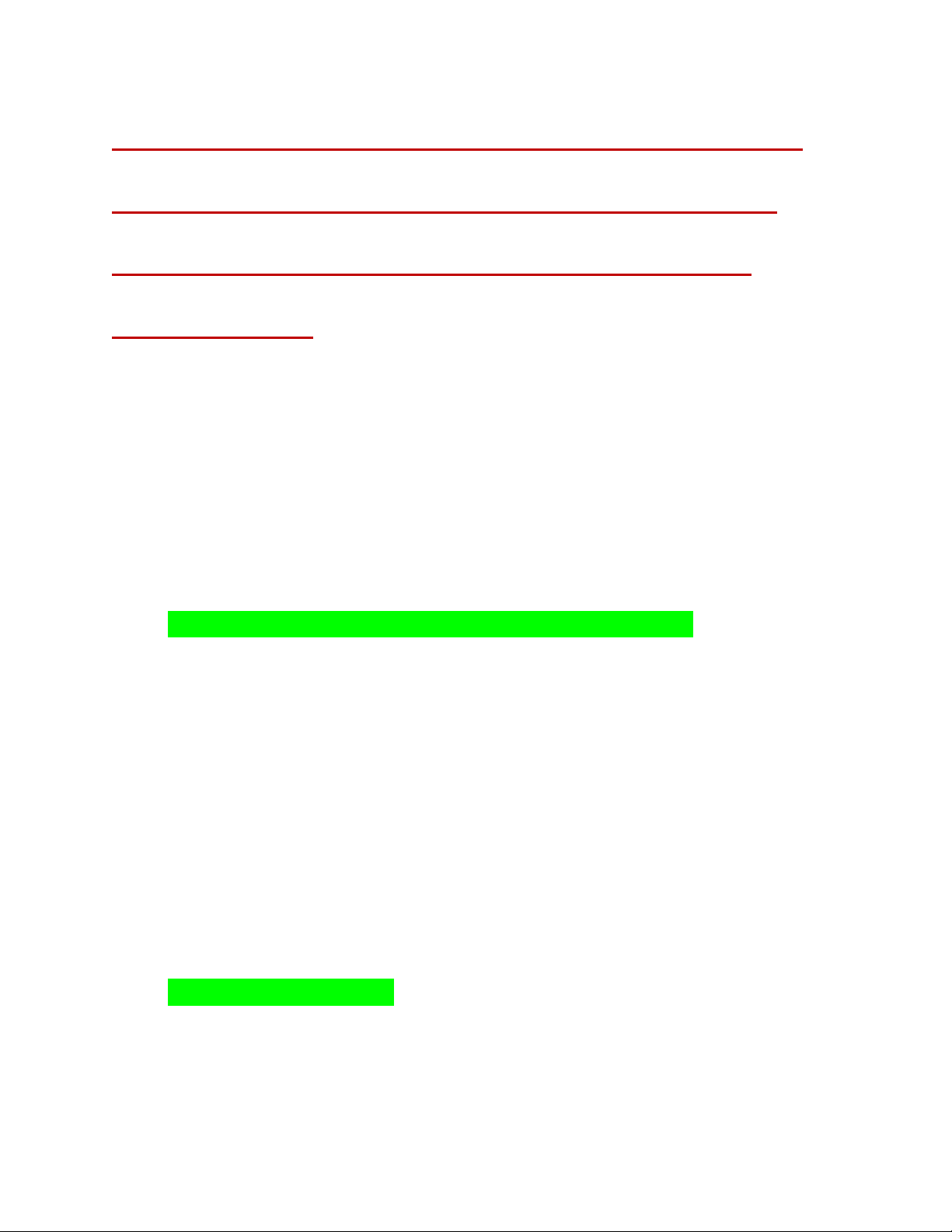
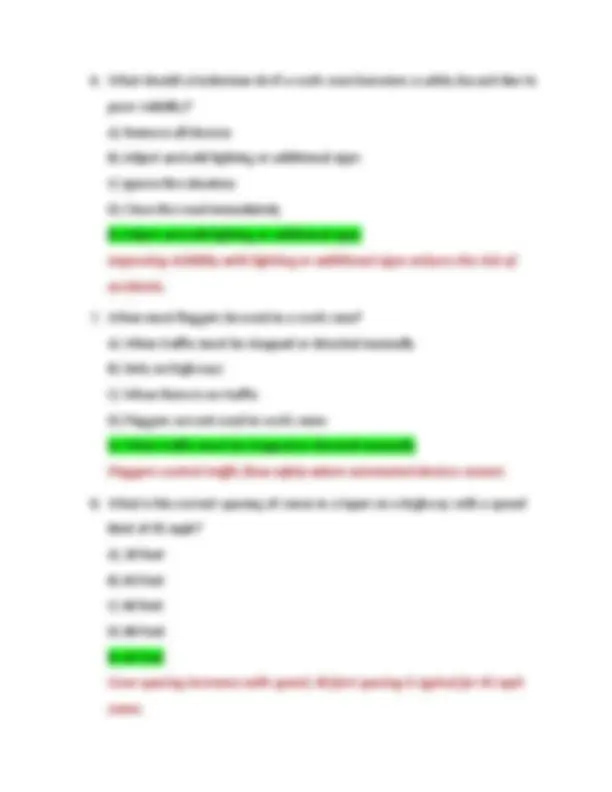
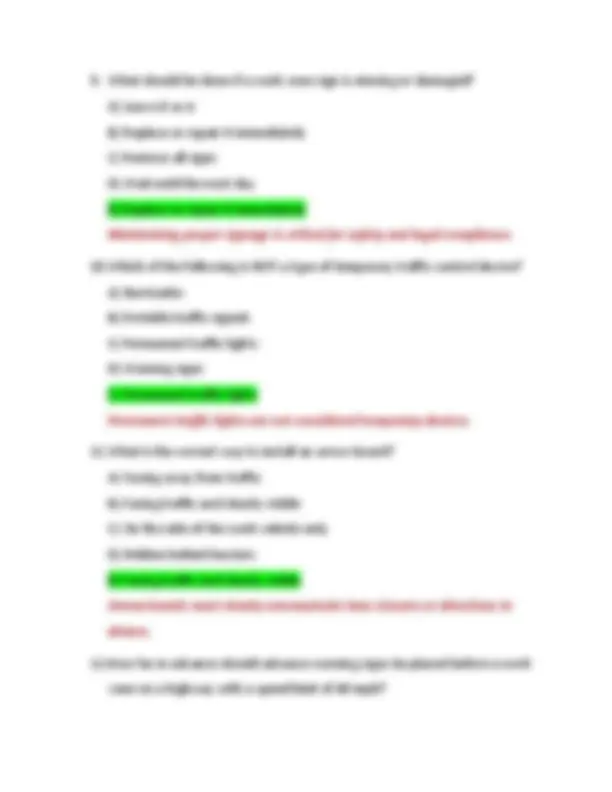
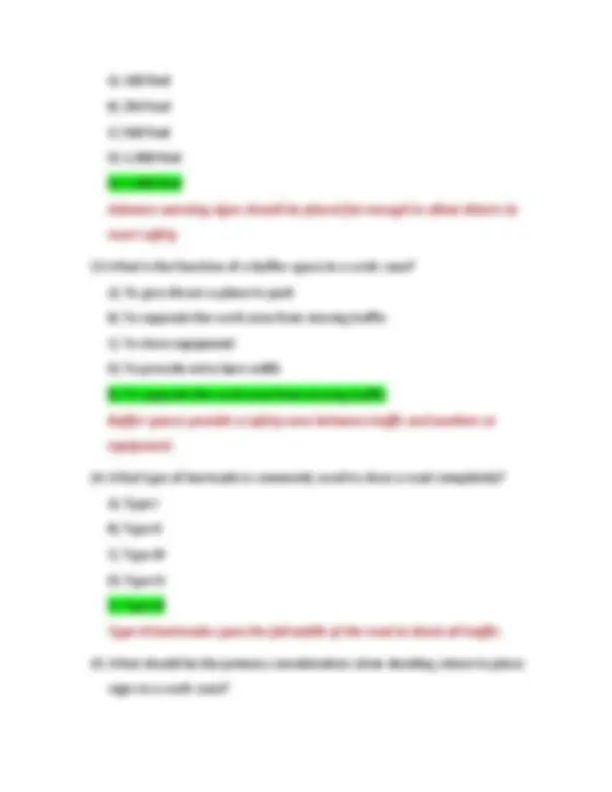
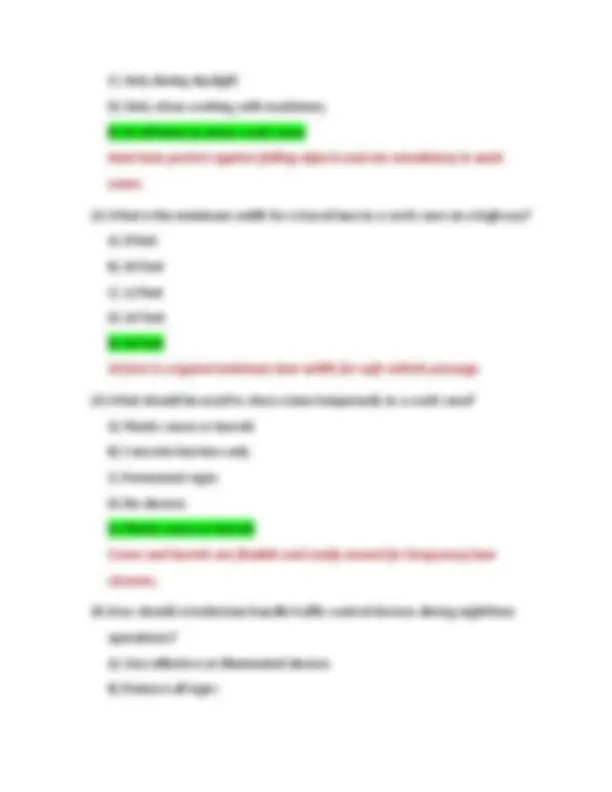
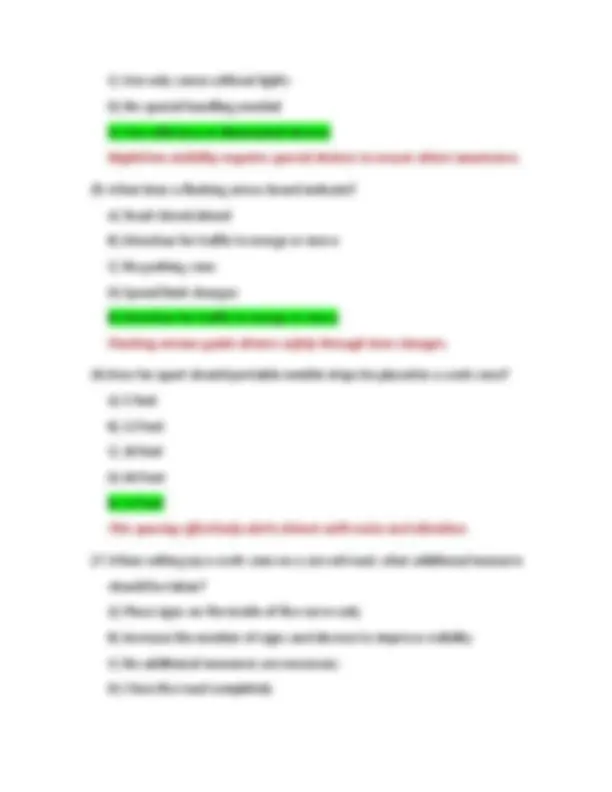
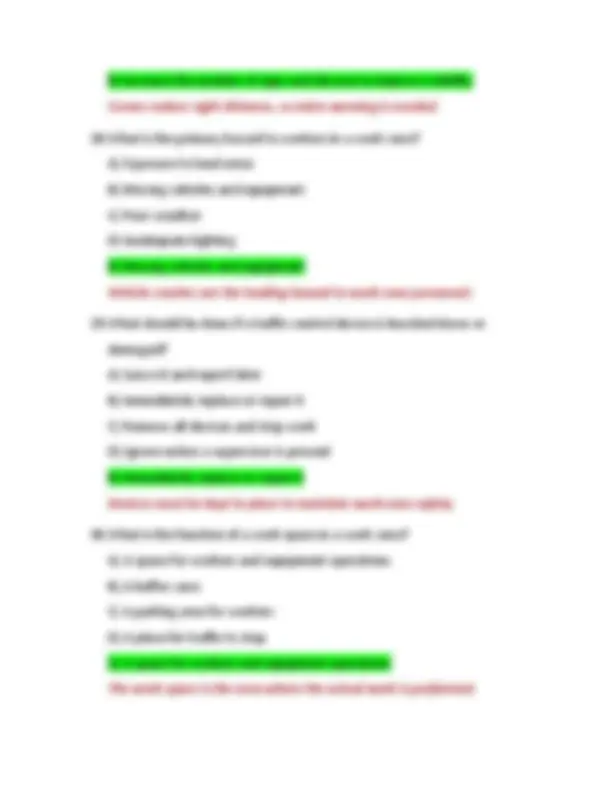
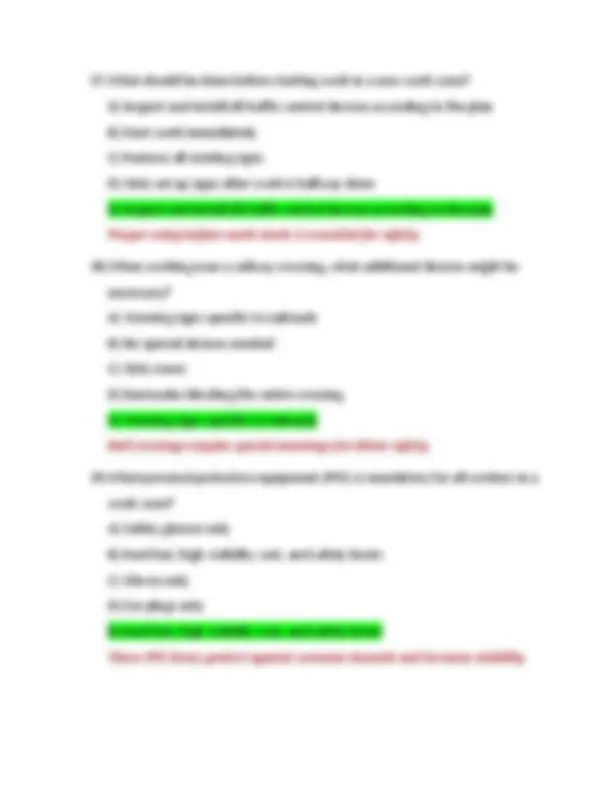
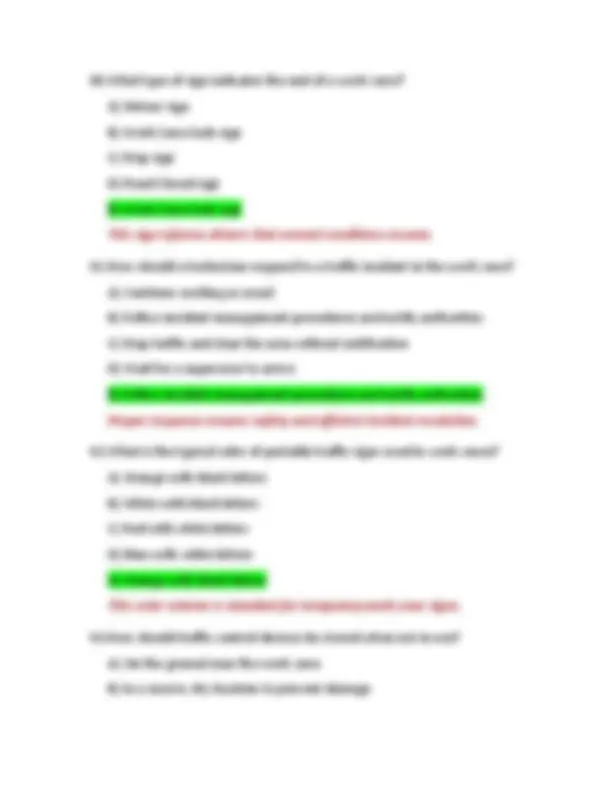
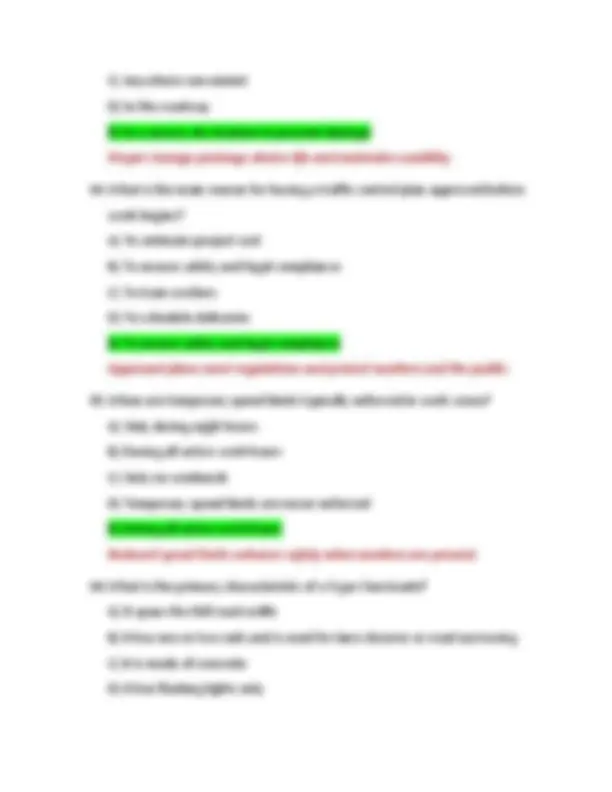
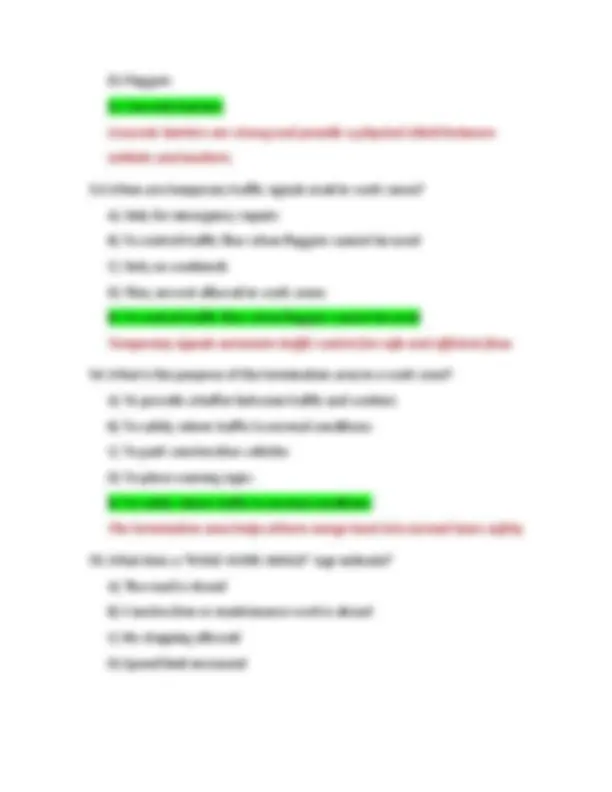
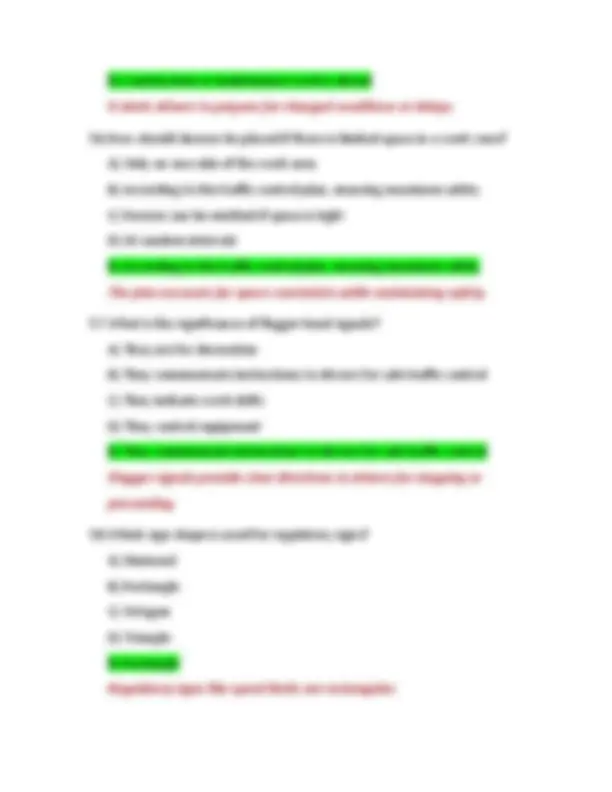
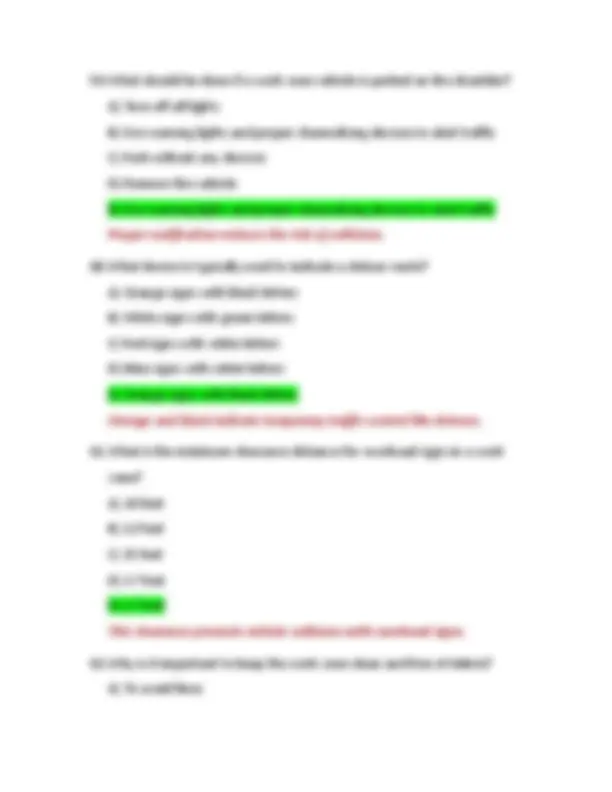
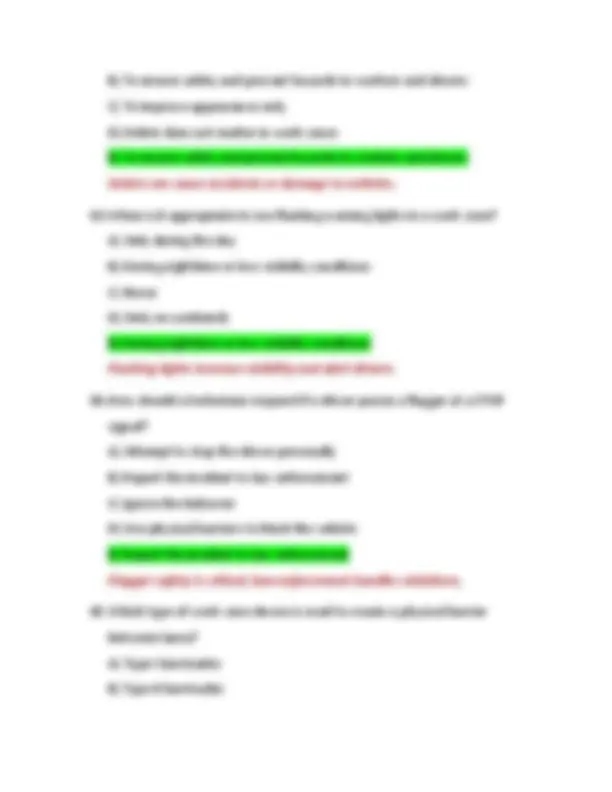
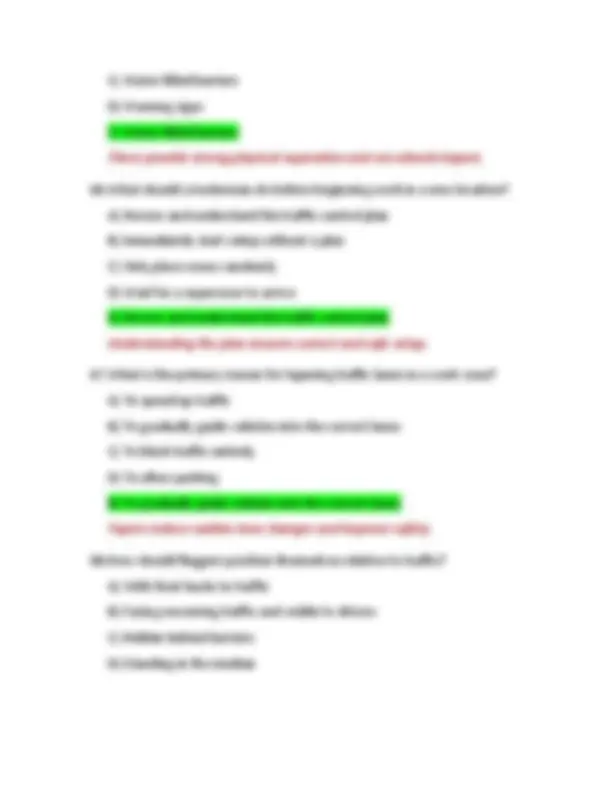
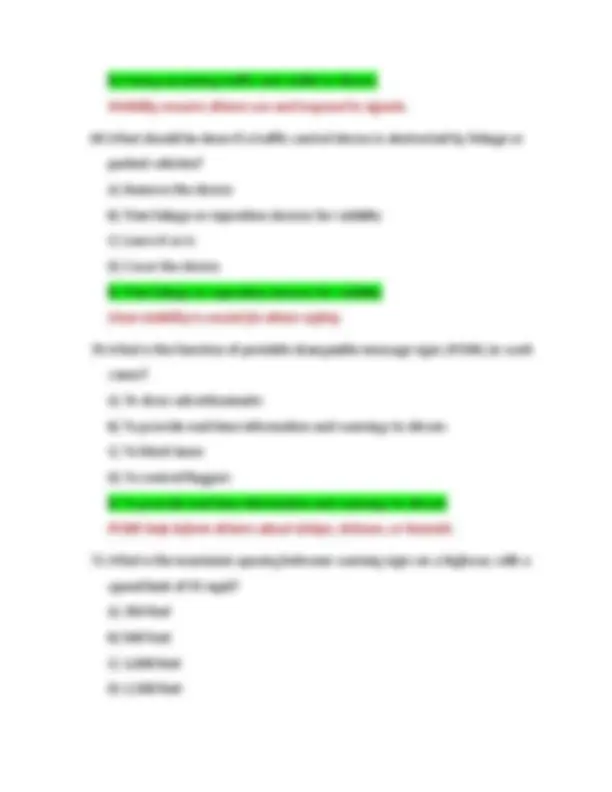
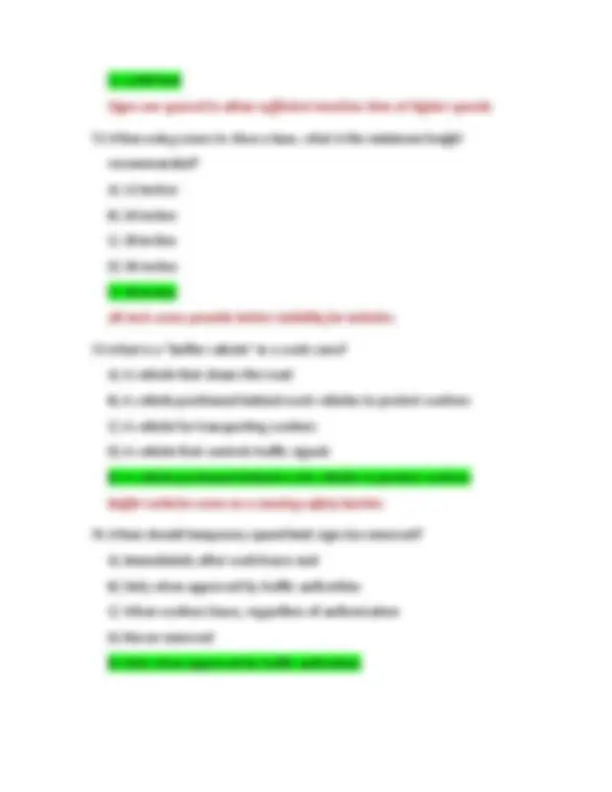
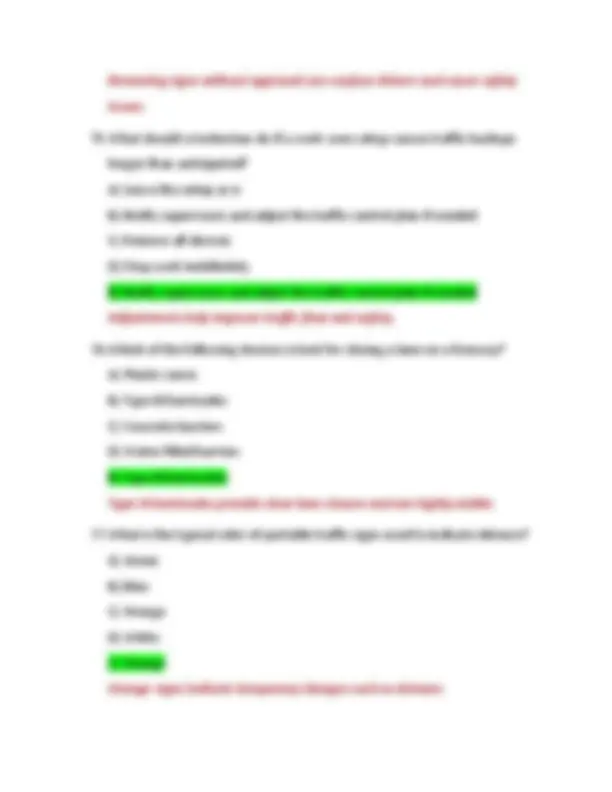
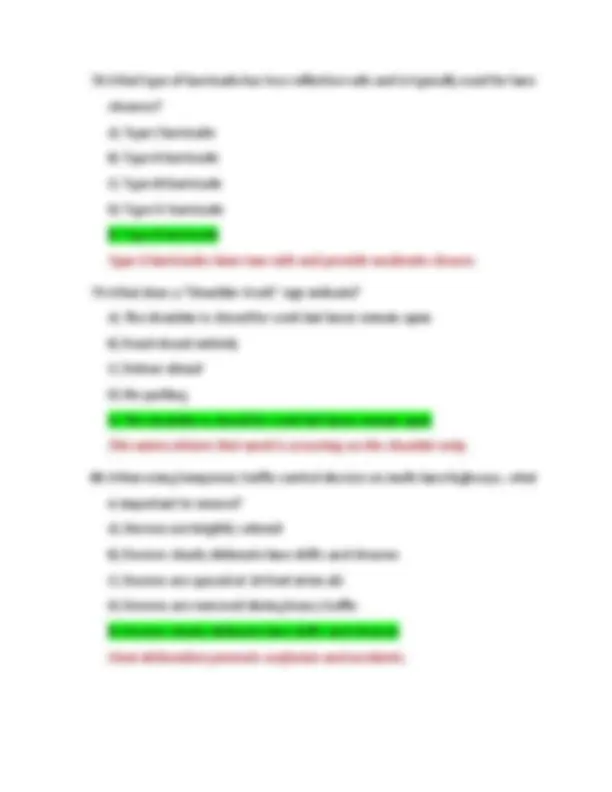
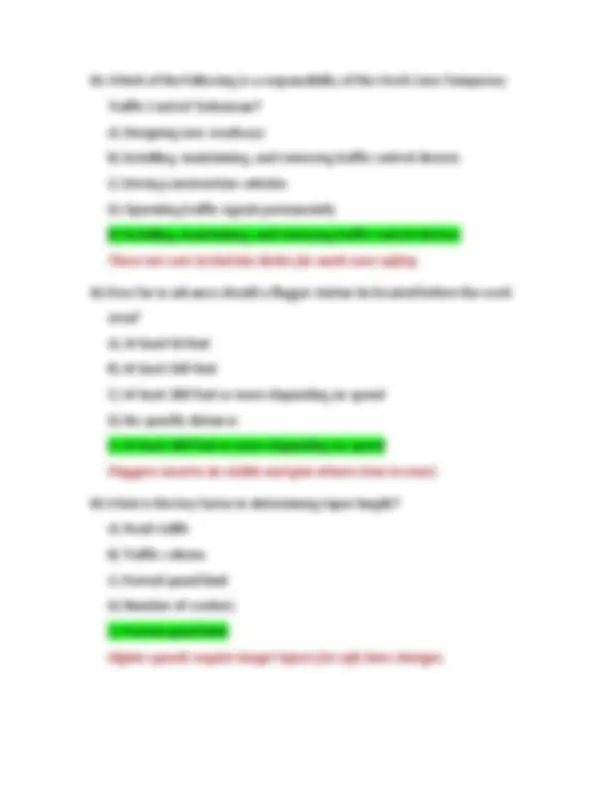
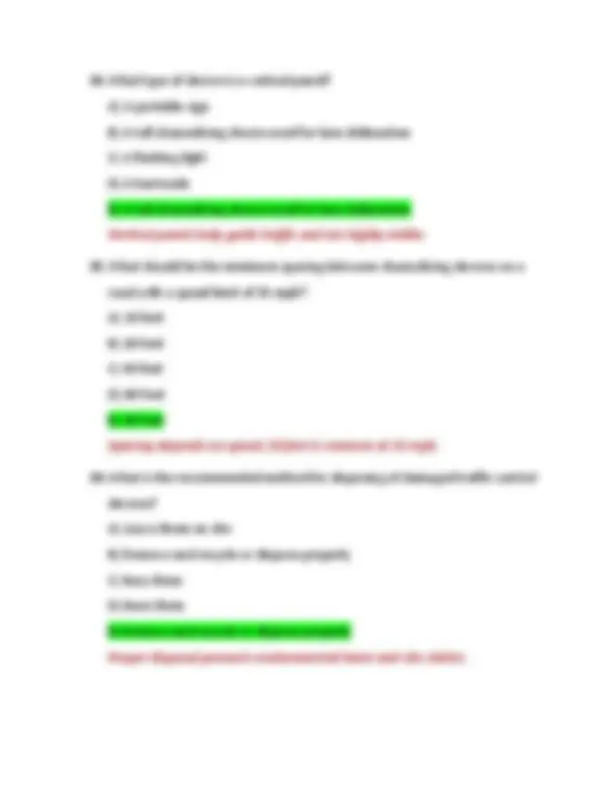
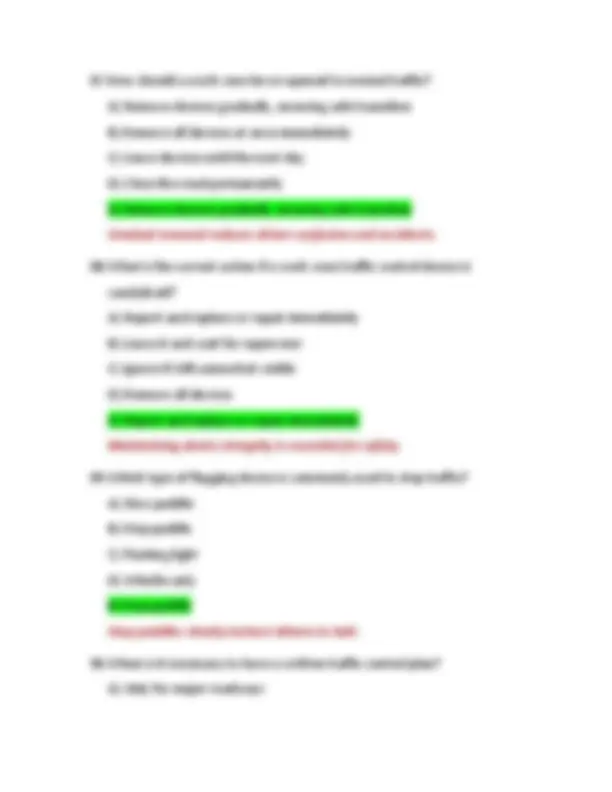
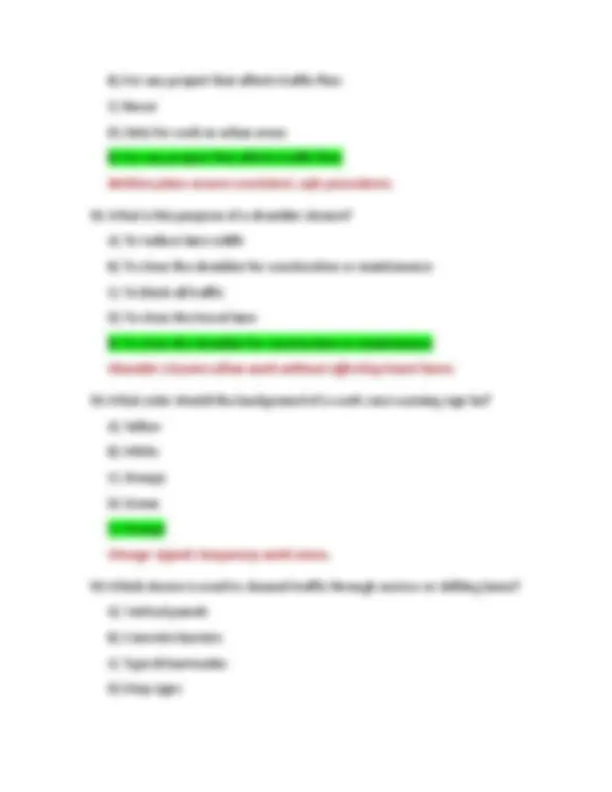
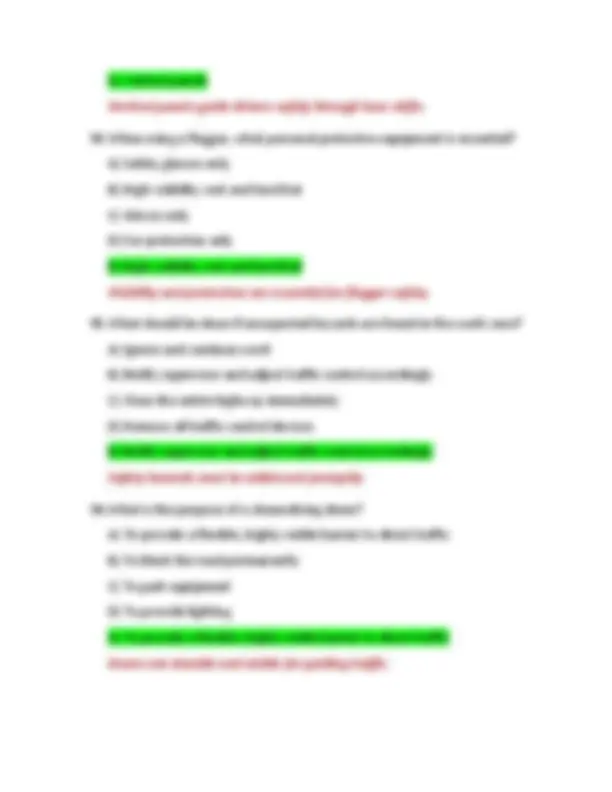
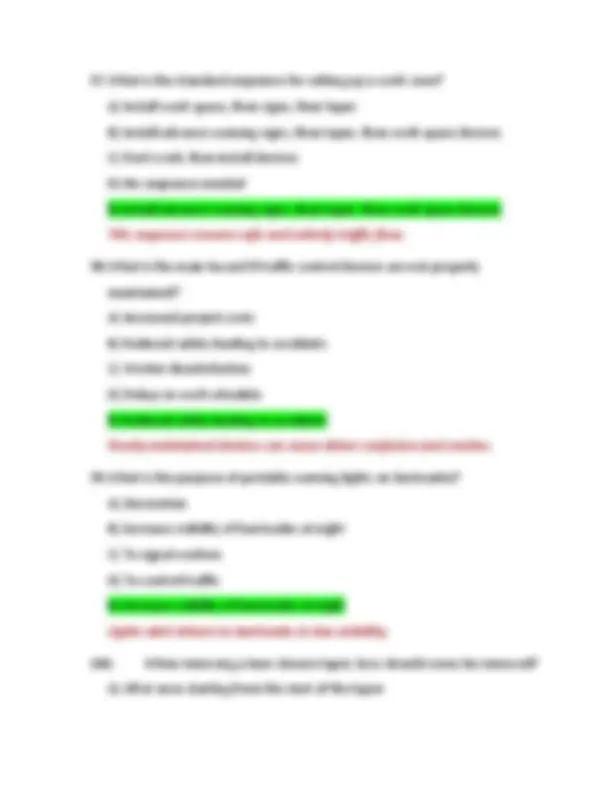
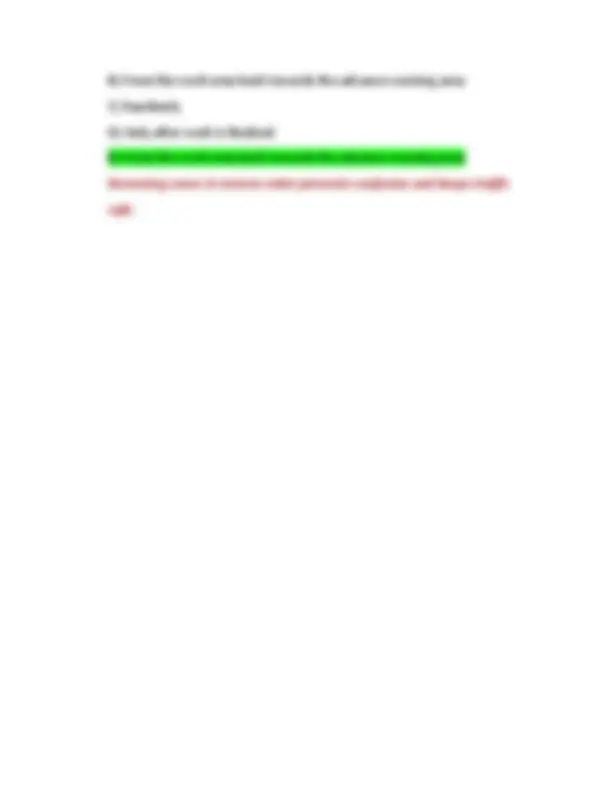


Study with the several resources on Docsity

Earn points by helping other students or get them with a premium plan


Prepare for your exams
Study with the several resources on Docsity

Earn points to download
Earn points by helping other students or get them with a premium plan
Community
Ask the community for help and clear up your study doubts
Discover the best universities in your country according to Docsity users
Free resources
Download our free guides on studying techniques, anxiety management strategies, and thesis advice from Docsity tutors
Work Zone Temporary Traffic Control Technician Exam Questions And Correct Answers (Verified Answers) Plus Rationales 2025 Q&A | Instant Download Pdf
Typology: Exams
1 / 33

This page cannot be seen from the preview
Don't miss anything!


























A) 100 feet B) 250 feet C) 500 feet D) 1,000 feet D) 1,000 feet Advance warning signs should be placed far enough to allow drivers to react safely. 13.What is the function of a buffer space in a work zone? A) To give drivers a place to park B) To separate the work area from moving traffic C) To store equipment D) To provide extra lane width B) To separate the work area from moving traffic Buffer spaces provide a safety zone between traffic and workers or equipment. 14.What type of barricade is commonly used to close a road completely? A) Type I B) Type II C) Type III D) Type IV C) Type III Type III barricades span the full width of the road to block all traffic. 15.What should be the primary consideration when deciding where to place signs in a work zone?
18.What is the maximum allowable distance between work zone signs? A) 500 feet B) 1,000 feet C) It depends on the speed limit and road conditions D) 100 feet C) It depends on the speed limit and road conditions Spacing is determined by factors like speed and road geometry. 19.Which device is used to separate opposing lanes of traffic in a work zone? A) Channelizing cones B) Barricades C) Concrete barriers D) Signs C) Concrete barriers Concrete barriers provide strong physical separation between lanes. 20.What is the typical color of a flagger’s vest? A) Blue B) Orange or fluorescent yellow-green C) Black D) Red B) Orange or fluorescent yellow-green These colors increase flagger visibility for safety. 21.When should a technician wear a hard hat in a work zone? A) Only when it is raining B) At all times in active work zones
C) Only during daylight D) Only when working with machinery B) At all times in active work zones Hard hats protect against falling objects and are mandatory in work zones. 22.What is the minimum width for a travel lane in a work zone on a highway? A) 8 feet B) 10 feet C) 12 feet D) 14 feet B) 10 feet 10 feet is a typical minimum lane width for safe vehicle passage. 23.What should be used to close a lane temporarily in a work zone? A) Plastic cones or barrels B) Concrete barriers only C) Permanent signs D) No devices A) Plastic cones or barrels Cones and barrels are flexible and easily moved for temporary lane closures. 24.How should a technician handle traffic control devices during nighttime operations? A) Use reflective or illuminated devices B) Remove all signs
B) Increase the number of signs and devices to improve visibility Curves reduce sight distance, so extra warning is needed. 28.What is the primary hazard to workers in a work zone? A) Exposure to loud noise B) Moving vehicles and equipment C) Poor weather D) Inadequate lighting B) Moving vehicles and equipment Vehicle crashes are the leading hazard to work zone personnel. 29.What should be done if a traffic control device is knocked down or damaged? A) Leave it and report later B) Immediately replace or repair it C) Remove all devices and stop work D) Ignore unless a supervisor is present B) Immediately replace or repair it Devices must be kept in place to maintain work zone safety. 30.What is the function of a work space in a work zone? A) A space for workers and equipment operations B) A buffer zone C) A parking area for workers D) A place for traffic to stop A) A space for workers and equipment operations The work space is the area where the actual work is performed.
31.What is the minimum distance for a taper on a highway with a 55 mph speed limit? A) 200 feet B) 400 feet C) 550 feet D) 825 feet D) 825 feet Taper lengths increase with speed; 825 feet is typical for 55 mph. 32.Which device is best for use on rough or uneven surfaces in a work zone? A) Traffic cones B) Water-filled barriers C) Concrete barriers D) Type II barricades B) Water-filled barriers They provide good stability and are safer on uneven ground. 33.What is the recommended action if a driver does not comply with a flagger's signals? A) The flagger should pursue the driver B) Notify law enforcement C) Ignore the behavior D) Use physical barriers to stop the driver B) Notify law enforcement Law enforcement handles traffic violations for safety.
37.What should be done before starting work in a new work zone? A) Inspect and install all traffic control devices according to the plan B) Start work immediately C) Remove all existing signs D) Only set up signs after work is halfway done A) Inspect and install all traffic control devices according to the plan Proper setup before work starts is essential for safety. 38.When working near a railway crossing, what additional devices might be necessary? A) Warning signs specific to railroads B) No special devices needed C) Only cones D) Barricades blocking the entire crossing A) Warning signs specific to railroads Rail crossings require special warnings for driver safety. 39.What personal protective equipment (PPE) is mandatory for all workers in a work zone? A) Safety glasses only B) Hard hat, high-visibility vest, and safety boots C) Gloves only D) Ear plugs only B) Hard hat, high-visibility vest, and safety boots These PPE items protect against common hazards and increase visibility.
40.What type of sign indicates the end of a work zone? A) Detour sign B) Work Zone Ends sign C) Stop sign D) Road Closed sign B) Work Zone Ends sign This sign informs drivers that normal conditions resume. 41.How should a technician respond to a traffic incident in the work zone? A) Continue working as usual B) Follow incident management procedures and notify authorities C) Stop traffic and clear the area without notification D) Wait for a supervisor to arrive B) Follow incident management procedures and notify authorities Proper response ensures safety and efficient incident resolution. 42.What is the typical color of portable traffic signs used in work zones? A) Orange with black letters B) White with black letters C) Red with white letters D) Blue with white letters A) Orange with black letters This color scheme is standard for temporary work zone signs. 43.How should traffic control devices be stored when not in use? A) On the ground near the work zone B) In a secure, dry location to prevent damage
B) It has one or two rails and is used for lane closures or road narrowing Type I barricades are lightweight and used for minor closures. 47.What is the correct procedure if a work zone has no traffic control devices present during active hours? A) Stop work and install devices immediately B) Continue working and install devices later C) Remove workers until the next day D) Ask drivers to slow down A) Stop work and install devices immediately No devices mean unsafe conditions, so work must pause until devices are installed. 48.How far should a buffer space be from the work area in a highway work zone? A) At least 5 feet B) At least 10 feet C) At least 30 feet or more depending on speed D) No buffer is needed C) At least 30 feet or more depending on speed Buffer distances increase with speed to protect workers. 49.Which device is used to provide positive protection between traffic and workers? A) Traffic cones B) Concrete barriers C) Warning signs
D) Channelizing drums B) Concrete barriers Concrete barriers provide strong physical protection. 50.When directing traffic, how should a flagger hold the stop/slow paddle? A) At waist level, facing traffic B) Down by their side C) Above their head D) Behind their back A) At waist level, facing traffic This ensures clear visibility and communication to drivers. 51.What is the purpose of an advance warning area in a work zone? A) To provide a space for workers to rest B) To alert drivers about upcoming work zone conditions C) To store equipment D) To direct workers where to park vehicles B) To alert drivers about upcoming work zone conditions Advance warning areas give drivers notice so they can slow down or change lanes safely. 52.Which device is commonly used to protect workers from errant vehicles on narrow roads? A) Concrete barriers B) Traffic cones C) Flashing lights
B) Construction or maintenance work is ahead It alerts drivers to prepare for changed conditions or delays. 56.How should devices be placed if there is limited space in a work zone? A) Only on one side of the work area B) According to the traffic control plan, ensuring maximum safety C) Devices can be omitted if space is tight D) At random intervals B) According to the traffic control plan, ensuring maximum safety The plan accounts for space constraints while maintaining safety. 57.What is the significance of flagger hand signals? A) They are for decoration B) They communicate instructions to drivers for safe traffic control C) They indicate work shifts D) They control equipment B) They communicate instructions to drivers for safe traffic control Flagger signals provide clear directions to drivers for stopping or proceeding. 58.Which sign shape is used for regulatory signs? A) Diamond B) Rectangle C) Octagon D) Triangle B) Rectangle Regulatory signs like speed limits are rectangular.
59.What should be done if a work zone vehicle is parked on the shoulder? A) Turn off all lights B) Use warning lights and proper channelizing devices to alert traffic C) Park without any devices D) Remove the vehicle B) Use warning lights and proper channelizing devices to alert traffic Proper notification reduces the risk of collisions. 60.What device is typically used to indicate a detour route? A) Orange signs with black letters B) White signs with green letters C) Red signs with white letters D) Blue signs with white letters A) Orange signs with black letters Orange and black indicate temporary traffic control like detours. 61.What is the minimum clearance distance for overhead signs in a work zone? A) 10 feet B) 12 feet C) 15 feet D) 17 feet D) 17 feet This clearance prevents vehicle collisions with overhead signs. 62.Why is it important to keep the work zone clean and free of debris? A) To avoid fines